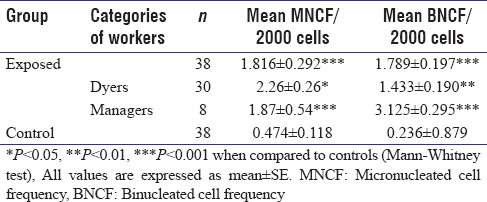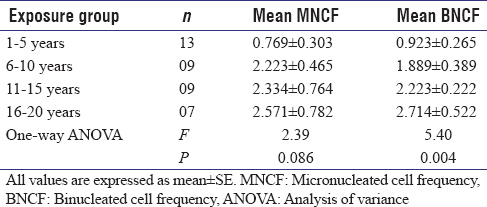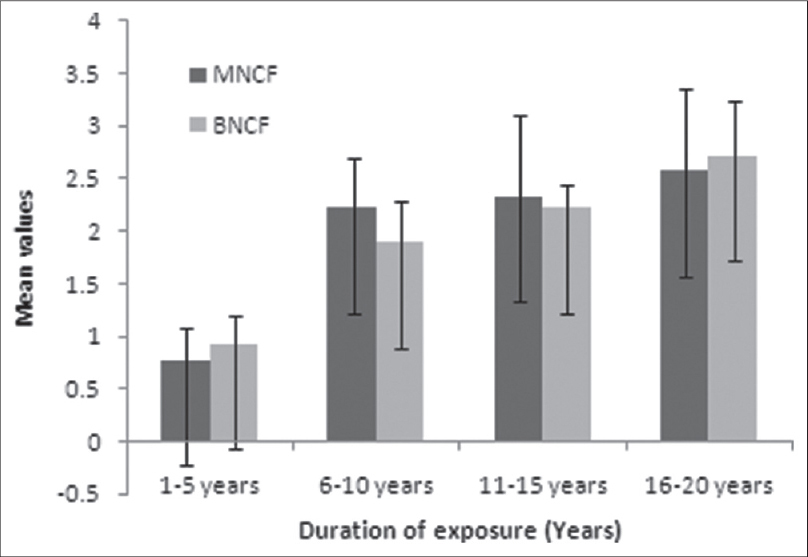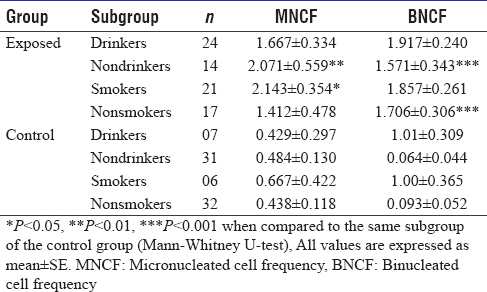|
 
 |
| ORIGINAL ARTICLE |
|
| Year : 2015 | Volume
: 1
| Issue : 2 | Page : 42-45 |
|
Human Health Hazard Posed by Textile Dyes: A Genotoxic Perspective
Zorawar Singh1, Pooja Chadha2
1 Department of Zoology, Khalsa College, Guru Nanak Dev University, Amritsar, Punjab, India
2 Department of Zoology, Guru Nanak Dev University, Amritsar, Punjab, India
| Date of Web Publication | 22-Sep-2015 |
Correspondence Address:
Dr. Pooja Chadha
Department of Zoology, Guru Nanak Dev University, Amritsar, Punjab - 143 005, India.
India
 Source of Support: None, Conflict of Interest: None  | Check |
 
Background: Thousands of workers are annually engaged in textile industries. The workers engaged in textile dyeing processes are occupationally exposed to different set of dyes. Methods: In the present study, a group of 38 workers from a dyeing unit including dyers (n = 30) and managers (n = 08) were assessed for genotoxicity using micronucleus test in buccal mucosal cells. An equal number of the subjects (n = 38) matched with the exposed individuals were chosen as controls. Results: The results showed a significant increase in the frequency of micronucleated (MNed) cells in the exposed group as compared to the controls (Mann Whitney, P<0.001). Conclusion: Our finding clearly indicated the genotoxic hazard related to dyes in textile industry workers. Keywords: DNA damage, dyes, genotoxicity, micronucleus test, textile industries
How to cite this article:
Singh Z, Chadha P. Human Health Hazard Posed by Textile Dyes: A Genotoxic Perspective. J Hum Health 2015;1:42-5 |
| Introduction | |  |
Extensive scientific and industrial development have resulted in the destruction of the environment, as well as adverse effects on human health. Occupational exposures to chemical agents in different industries pose a major carcinogenic risk. Textile industries are using different varieties of dyes, solvents, bleaching agents, finishing chemicals, acids, alkalies, and metals including copper (Cu), cadmium (Cd), zinc (Zn), chromium (Cr), and iron (Fe).[1] Many aromatic dyes are known to be the derivatives of benzene, toluene, naphthalene, phenol, and aniline.[2] Many recent studies have also shown the association of cancer with the textile industry.[3],[4],[5],[6],[7] Cotton industry workers have been shown to have pulmonary dysfunctions.[8] The effect of dyes on human health has been previously discussed in different industries.[9],[10],[11],[12],[13],[14] Dyes being used in textile industry pose a major carcinogenic risk for the workers.[15],[16] Dye workers have been shown to suffer from different types of cancers including urothelial cancer.[17],[18],[19] Dyes which are the derivatives of amines have also been found to cause cancer.[20] One of the previous studies reveals the genotoxic effect of fiber dust in textile cutting workers as assessed by micronucleus frequency (Workers: 3.30 ± 0.35 vs. Controls: 0.06 ± 0.05; P < 0.05).
The threat of occupational exposure to human health is still poorly understood for its nature and magnitude. The detection of genotoxic effects of mutagenic and carcinogenic chemicals being used in different industries by adequate means as early carcinogenic markers is the basic element in cancer prevention strategies. In this study an attempt has been made to assess the occupational genotoxicity in the textile industry workers on the basis of the nature of their job and exposure to a particular set of dyes.
| Materials and Methods | |  |
Population studied
After taking the due consent, a population of 76 individuals was analyzed for the present study. Totally, 38 subjects including 30 dyers and 8 managers were chosen from a textile industry in the region of Ludhiana, Punjab, who was exclusively working in the dyeing area. They were using a set of different dyes. An equal number of controls (n = 38) who had not been subjected to any kind of exposure to the textile industry was chosen as controls. This group of individuals contained normal healthy individuals belonging to the same socioeconomic strata, age group, sex, drinking, and smoking habits. They had not been subjected to any kind of dye exposure and had not undergone any X-ray therapy, at least 3 months prior to the sampling.
Epidemiological survey
Prior to sampling, information on personal, medical, exposure histories, and protective measures from each subject were recorded. The questionnaire included the information of their name, sex, age, drinking habit, duration of exposure, smoking habit, use of protective equipment, previous exposures, and their medical record. The data were recorded for both the exposed and the control groups.
Preparation of slides
Slides for the buccal micronucleus test were prepared according to Singh and Chadha.[21] After moistening the mouth, exfoliated cells were collected from the oral or buccal mucosa by swabbing with a wooden spatula. Smears of the buccal mucosal cells were prepared on the slides. The slides were coded according to the subjects for further identification.
Fixation and hydrolysis
Within 3–4 h of sampling, the air-dried slides were fixed in freshly prepared fixative (glacial acetic acid and methanol; 1:3) for 15 min. Again the slides were air dried. The buccal smear preparation was hydrolyzed in 1N HCl at 60°C for 8 min followed by a rinse in double distilled water.
Aceto-orocein staining
The slides were placed in a couplin jar containing a solution of an aceto-orocein stain for 20 min at 40°C. After this, the slides were washed with ethanol and double distilled water.
Counter staining with fast green
Counterstaining was carried out by placing washed slides in a coupling jar containing 0.1% fast green solution for 12 min. After rinsing with ethanol and distilled water, the air dried, and stained slides were mounted in DPX.
Scoring of slides
The air-dried slides were scored as per the methodology of Tolbert et al.[22] under a trinocular microscope (Olympus CX-31). 2000 cells per slide were scored for the presence of micronucleated (MNed) cells and binucleated (BNed) cells.
Statistical analysis
The data were normalized using square root transformation. The difference in the frequencies of MNed cells between the control and exposed groups was analyzed using Mann–Whitney U-test. A one-way analysis of variance (ANOVA) was applied to assess the effect of duration of exposure on the frequency of MNed and BNed cells. P < 0.05 was considered as the significant level of the statistical analysis. All statistical analyses were performed using the program Minitab version 16.1.0 (Minitab Inc.) for windows.
| Results | |  |
In the present study, a group of 38 textile industry workers were selected for the evaluation of genotoxicity following exposure to multiple dyes. Characteristics of exposed subjects are given in [Table 1]. The exposed group was further categorized on the basis of their nature of job namely dyers (n = 30) and managers (n = 08). Duration of exposure in textile industry workers came out to be 9.89 ± 1.14 years. The exposed as well as the control group was further categorized into drinker/nondrinker and smoker/nonsmoker groups on the basis of their alcohol taking and smoking habits. About 63.15% and 55.26% workers were found to be drinkers and smokers, respectively. | Table 1: Characteristics of subjects of textile industry workers and controls
Click here to view |
MNed cell frequency (MNCF) and BNed cell frequency (BNCF) were assessed from buccal mucosa slides. From the micronucleus test [Table 2], it was revealed that the MNCF for the exposed group (n = 38) was significantly different from controls (1.816 ± 0.292 vs. 0.474 ± 0.118; W = 1795, P = 0.0002). The group of dyers (n = 30) and managers (n = 08) were separately analyzed for the level of significance for MNCF. The results revealed a significantly higher MNCF among dyers (W = 1217, P = 0.0127) and managers (W = 337.5, P = 0.000) as compared to controls. Similarly, the BNCF was found to be significantly higher among exposed group when compared to the controls (1.789 ± 0.197 vs. 0.236 ± 0.879; W = 1993, P = 0.000). BNed cell frequency among dyer and managerial groups were also found be significantly higher as compared to control group (Dyers, W = 1415, P = 0.000; Managers, W = 743, P = 0.000). | Table 2: Mean values of MNCF and BNCF in textile industry workers (n=38)
Click here to view |
The effect of confounders on both the end points was also assessed. The exposed subjects were categorized into four exposure groups (1–5, 6–10, 11–15, and 16–20 years) on the basis of their duration of exposure. Mean MNCF and BNCF were assessed for all the four groups. It was found that higher values for MNCF were observed in higher exposure groups but the trend failed to reach statistical significance (one-way ANOVA, General Linear Model (GLM): F =2.39, P = 0.086) [Table 3] and [Figure 1]. However, the results revealed a significant increase in BNCF among textile industry workers with respect to increasing exposure years (one-way ANOVA, GLM: F =5.40, P = 0.004). Drinking and smoking habits were also assessed for their effect on both the endpoints. The values for MNCF were found to be nonsignificantly higher in the exposed drinkers as compared to control drinkers (P = 0.06), but was found to be significantly higher in exposed nondrinkers as compared to control nondrinkers (P = 0.003). On the same line, the BNed cell frequency was observed to be significantly higher among exposed subjects only in nondrinking group (P = 0.000) but failed to reach significance in case of exposed and control drinkers (P = 0.073). Smoking was found to have a significant effect on MNCF among smoking workers (P = 0.03) when compared to smoking controls, but was having a nonsignificant effect on nonsmoking groups (P = 0.142). On the contrary, BNed cell frequency was found to be significantly higher only among nonsmoking workers when compared to control nonsmokers (P = 0.000). | Table 3: Mean values of MNCF and BNCF in textile industry workers with respect to duration of exposure
Click here to view |
 | Figure 1: Increasing trends in micronucleated cell frequency and binucleated cell frequency among textile industry workers. MNCF: Micronucleated cell frequency, BNCF: Binucleated cell frequency
Click here to view |
| Discussion | |  |
In the present study, 38 textile industry workers were assessed for the genotoxic effect of dyes being used in the industry. Micronucleus test has been widely used for genotoxicity studies.[23],[24],[25],[26],[27] In the present study also, micronucleus test was employed to assess the genotoxic effect. Overall, the MNCF and BNCF were found to be significantly higher among the exposed group when compared to the control group (P = 0.0002 and 0.000, respectively, [Table 2]). Different studies have also shown an increased genotoxicity following exposure to dyes.[28],[29],[30],[31] As per [Table 1], duration of exposure was highest in the managerial staff (n = 08) with a range of 40–50 years. The dyers were also having a high duration of exposure in the industry (range: 27–55 years). As the duration of exposure is thought to increase the magnitude of genotoxicity, the mean BNCF was found to be increased with increasing duration of exposure (one-way ANOVA, P = 0.004, [Figure 1]). However, in case of MNCF, the increasing trend failed to reach the statistical significance (P = 0.086). The effect of confounding factors was also determined on the endpoints. Alcohol drinking habit failed to affect the values of both the endpoint parameters, whereas, the smoking habit was found to affect only the MNCF among textile industry workers (P = 0.03, [Table 3]). Smoking has been associated with oxidative stress and may contribute to genotoxicity indirectly.[32] One of the previous studies reported higher oxidative stress levels among grinders.[33] As three out of four parameters in the present study (Exposed drinker and smoker subgroups, [Table 4]) were not found to be affected by confounders in a significant way, thus indicate a clear association with exposure to dyes. The results of the present study indicate a potential genotoxic effect of dyes in the textile industry workers. | Table 4: Mean values of MNCF and BNCF among exposed and control groups with respect to drinking and smoking habits
Click here to view |
| Conclusion | |  |
The textile sector is one of the leading sectors in India and annually employs lakhs of workers to meet their demands. Textile industries are using different varieties of dyes which are genotoxic in nature which is confirmed in the present study. The workers exposed to dyes are prone to genotoxicity which may result in different health related problems. Conclusively, Textile industry workers exposed to dyes must use proper protection equipment to minimize the exposure.
Financial support and sponsorship
Nil.
Conflicts of interest
There are no confl icts of interest.
| References | |  |
| 1. | IARC. Monographs on the Evaluation of Carcinogenic Risk to Humans. Lyon: IARC; 1997. p. 545-51.  |
| 2. | Ragunathan I, Panneerselvam N. Antimutagenic potential of curcumin on chromosomal aberrations in Allium cepa. J Zhejiang Univ Sci B 2007;8:470-5.  |
| 3. | Kwon P, Lundin J, Li W, Ray R, Littell C, Gao D, et al. Night shift work and lung cancer risk among female textile workers in Shanghai, China. J Occup Environ Hyg 2015;12:334-41.  |
| 4. | Gallagher LG, Li W, Ray RM, Romano ME, Wernli KJ, Gao DL, et al. Occupational exposures and risk of stomach and esophageal cancers: Update of a cohort of female textile workers in Shanghai, China. Am J Ind Med 2015;58:267-75.  |
| 5. | Li W, Ray RM, Thomas DB, Davis S, Yost M, Breslow N, et al. Shift work and breast cancer among women textile workers in Shanghai, China. Cancer Causes Control 2015;26:143-50.  |
| 6. | Wang X, Lin S, Yano E, Yu IT, Courtice M, Lan Y, et al. Exposure-specific lung cancer risks in Chinese chrysotile textile workers and mining workers. Lung Cancer 2014;85:119-24.  |
| 7. | Li W, Ray RM, Thomas DB, Yost M, Davis S, Breslow N, et al. Occupational exposure to magnetic fields and breast cancer among women textile workers in Shanghai, China. Am J Epidemiol 2013;178:1038-45.  [ PUBMED] |
| 8. | Kahraman H, Sucakli MH, Kilic T, Celik M, Koksal N, Ekerbicer HC. Longitudinal pulmonary functional loss in cotton textile workers: A 5-year follow-up study. Med Sci Monit 2013;19:1176-82.  |
| 9. | Turgut T, Tasdemir C, Muz MH, Deveci F, Kirkil G. The prevalence of occupational asthma in auto and furniture dye workers in downtown Elazig. Tuberk Toraks 2005;53:371-8.  |
| 10. | Seeber H, Fikentscher R, Roseburg B. Smell- and taste disturbances in chromium dye workers. Z Gesamte Hyg 1976;22:820-2.  [ PUBMED] |
| 11. | Kadlubowski R. Simplified hippurin test and its application in dye workers. Pol Tyg Lek (Wars) 1956;11:1623-7.  [ PUBMED] |
| 12. | Piotrowski J. Attempted application of biochemical indexes of absorption of aniline, nitrobenzene and benzene in dye workers. Med Pr 1954;5:299-307.  [ PUBMED] |
| 13. | Ettinger A, Chylewski W. Etiology, pathogenesis, clinical aspects and prevention of occupational skin disease in dye workers. Przegl Dermatol 1954;4:31-7.  [ PUBMED] |
| 14. | Macalpine JB. Papilloma of the renal pelvis in dye workers; two cases, one of which shows bilateral growths. Br J Surg 1947;35:137-40.  [ PUBMED] |
| 15. | Bulbulyan MA, Figgs LW, Zahm SH, Savitskaya T, Goldfarb A, Astashevsky S, et al. Cancer incidence and mortality among beta-naphthylamine and benzidine dye workers in Moscow. Int J Epidemiol 1995;24:266-75.  |
| 16. | Muller A. Multiple carcinomata in dye workers. Helv Chir Acta 1951;18:156.  [ PUBMED] |
| 17. | Shinka T, Ogura H, Morita T, Nishikawa T, Fujinaga T, Ohkawa T. Relationship between glutathione S-transferase M1 deficiency and urothelial cancer in dye workers exposed to aromatic amines. J Urol 1998;159:380-3.  |
| 18. | Shinka T, Miyai M, Sawada Y, Inagaki T, Okawa T. Factors affecting the occurrence of urothelial tumors in dye workers exposed to aromatic amines. Int J Urol 1995;2:243-8.  |
| 19. | Shinka T, Sawada Y, Morimoto S, Fujinaga T, Nakamura J, Ohkawa T. Clinical study on urothelial tumors of dye workers in Wakayama City. J Urol 1991;146:1504-7.  |
| 20. | Baader EW. Occupational cancer caused by amines in dye workers. Arch Gewerbepathol Gewerbehyg 1961;18:410-5.  [ PUBMED] |
| 21. | Singh Z, Chadha P. Genotoxic effect of fibre dust among textile industry workers. J Environ Sci Sustain 2013;1:81-4.  |
| 22. | Tolbert PE, Shy CM, Allen JW. Micronuclei and other nuclear anomalies in buccal smears: Methods development. Mutat Res 1992;271:69-77.  |
| 23. | Chequer FM, Venâncio VP, Bianchi ML, Antunes LM. Genotoxic and mutagenic effects of erythrosine B, a xanthene food dye, on HepG2 cells. Food Chem Toxicol 2012;50:3447-51.  |
| 24. | Marzin D, Kirkland D. 2-Hydroxy-1,4-naphthoquinone, the natural dye of Henna, is non-genotoxic in the mouse bone marrow micronucleus test and does not produce oxidative DNA damage in Chinese hamster ovary cells. Mutat Res 2004;560:41-7.  |
| 25. | Sellappa S, Prathyumnan S, Joseph S, Keyan KS, Balachandar V. Genotoxic effects of textile printing dye exposed workers in India detected by micronucleus assay. Asian Pac J Cancer Prev 2010;11:919-22.  |
| 26. | Tsuboy MS, Angeli JP, Mantovani MS, Knasmüller S, Umbuzeiro GA, Ribeiro LR. Genotoxic, mutagenic and cytotoxic effects of the commercial dye CI Disperse Blue 291 in the human hepatic cell line HepG2. Toxicol In Vitro 2007;21:1650-5.  |
| 27. | Zeller A, Pfuhler S. N-acetylation of three aromatic amine hair dye precursor molecules eliminates their genotoxic potential. Mutagenesis 2014;29:37-48.  |
| 28. | Leme DM, Oliveira GA, Meireles G, Brito LB, Rodrigues Lde B, Palma de Oliveira D. Eco- and genotoxicological assessments of two reactive textile dyes. J Toxicol Environ Health A 2015;78:287-300.  |
| 29. | Shirin S, Balakrishnan VK. Using chemical reactivity to provide insights into environmental transformations of priority organic substances: The Fe°-mediated reduction of Acid Blue 129. Environ Sci Technol 2011;45:10369-77.  |
| 30. | Marlasca MJ, Sanpera C, Riva MC, Sala R, Crespo S. Hepatic alterations and induction of micronuclei in rainbow trout ( Oncorhynchus mykiss) exposed to a textile industry effluent. Histol Histopathol 1998;13:703-12.  |
| 31. | Przybojewska B, Baranski B, Spiechowicz E, Szymczak W. Mutagenic and genotoxic activity of chosen dyes and surface active compounds used in the textile industry. Pol J Occup Med 1989;2:171-85.  |
| 32. | Singh Z, Chadha P, Sharma S. Evaluation of oxidative stress and genotoxicity in battery manufacturing workers occupationally exposed to lead. Toxicol Int 2013;20:95-100.  [ PUBMED]  |
| 33. | Singh Z, Chadha P. Oxidative stress assessment among iron industry grinders. Biochem Cell Arch 2013;12:65-8.  |
[Figure 1]
[Table 1], [Table 2], [Table 3], [Table 4]
|